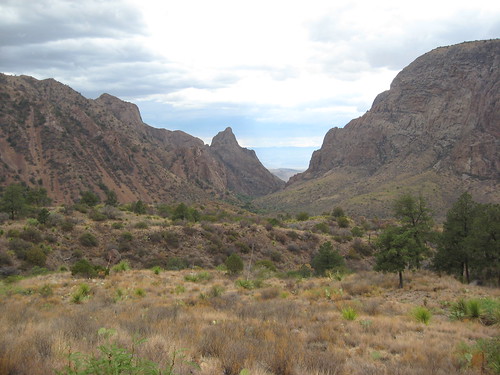
Location: Western Texas in Southernmost Brewster County along the border with Mexico.
Introduction:
I have been wanting to do a post on Big Bend for a long time, mainly because most of my fellow paleontology graduate students were doing work on material from here, but I couldn't put a post together till I had been there [Image at top looking out the Window in the Chisos by author]. Finally as I was getting ready to leave Lubbock I convinced one of the other students to drive out there with me for a couple of days so I can now say I have been even if we played tourist at the end of July and were trying not to melt the whole time we were there (note: it is hot in the desert in July).
Big Bend National Park (Wikipedia page) is not a national park that you just happen upon you have to make the conscious effort to get there. The fact is even the county it is in is off most peoples beaten path, there are no interstates that go through the county, and with a population of ~10,000 people very few people will ever visit the area. Big Bend is also in the middle of a desert which most people tend to avoid, especially during the hot summers which also happen to be when most tourists visit the other national parks. All of these reasons make Big Bend one of the least visited of the parks in the NPS system.
I mentioned that Big Bend is in the desert and it is part of the Chihuahuan Desert this desert extends up into New Mexico in fact 2 previous national park series posts, Guadalupe Mountains and Carlsbad, have talked about parks in this desert. Now this is not the desert that most people picture when they think desert, there are no big cacti and tons of sand. What there is instead is a very dry environment with for the most part low growing plants that have adapted to be able to live with little to no water for extended periods of time and when they do get water they make the most of it. There is plenty of mesquite as well with its long roots that reach deep for water and can find water in even the driest of environments. But there is more than just desert as the park varies from 1800 feet up to over 7000 feet there is a wide range of climatic differences. The Rio Grande and its flood plain make of a rich fertile wet soil that keeps plants growing almost year round and in the valley actually makes it quite humid. The desert has two ranges one the high desert and the other the low desert both have unique and varying vegetation types. And finally the Chisos Mountains that extend from the desert floor reaching up to the sky, the basin in them where the campsites are is over a mile high, the micro-climate here is cooler, I woke up in the morning actually cold and wanted to put on a long sleeve shirt, and more wet than the surrounding area and is the only place in the park where true trees can and do grow, also home to bears and mountain lions.
Ok I have rambled on long enough with the intro but lets just say if you happen to be nearby for whatever reason go visit Big Bend it is worth your time.
Geology:
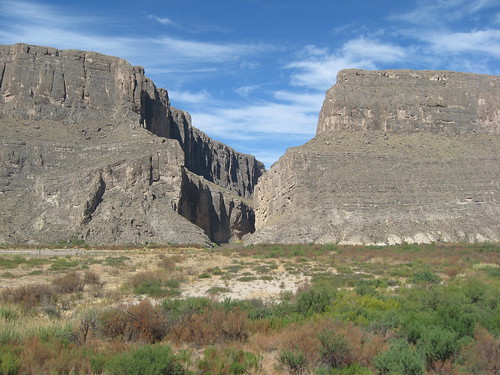 This park is so large (~800,000 acres) and has such a vast diverse geologic history that this is really only going to be an extremely brief summary of the geology of the park because I could ramble on for a long time about it [Image at left of Santa Elena Canyon by author].
This park is so large (~800,000 acres) and has such a vast diverse geologic history that this is really only going to be an extremely brief summary of the geology of the park because I could ramble on for a long time about it [Image at left of Santa Elena Canyon by author].
In the Triassic while Pangaea was still around this area of the country was exposed to the surface so unlike good chunks of the rest of the state there are no Triassic rocks in Big Bend. During the Triassic and Jurassic, however, Pangaea began to break apart this caused many of the rift valleys on the east coast of the United States and slowly started to allow for subsidence of the middle portion of the country. By the Cretaceous a large body of salt water that connected the still forming Gulf of Mexico to the Arctic Ocean, this was known as the Western Interior Seaway. This seaway was shallow and warm which is the perfect conditions for calcium carbonate secreting organisms to live in and these organisms form limestone deposits, see Guads, Carlsbad, and Mammoth Cave posts. These limestone deposits form the famous Glen Rose Formation in most of Texas along with most of the other limestone formations in the center of the state, they also form the limestone and chalk formations up into Kansas where the less famous, but equally important, Niobrara Chalk is. In the park there are thin bands of the Glen Rose but the most obvious example of this limestone is the massive limestone cut by the Rio Grande to form Santa Elena Canyon.
Late in the Cretaceous the sea level fell and the Western Interior Seaway began to recede toward the Gulf of Mexico, in the U.S. at least. As the sea level dropped river systems began to flow through the region and toward the very end of the Cretaceous portions of the park where underwater and portions where on land. During this time many dinosaurs lived in the area and in the formations that represent this time we find their fossils. The dinosaurs weren't alone during this time as the pterosaurs had grown to their largest size yet and Big Bend represents the type location of one of the largest the ~10 meter wing spanned Quetzalcoatlus northropi (Wikipedia page). The actual contact that represents the end of the dinosaurs, that famous iridium layer, is not found in the park although it should be no one has found the contact yet, although we are still looking.
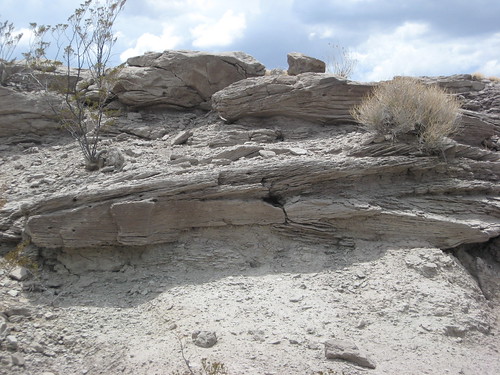 Whatever happened to the contact the area continued on being a warm wet swampy habitat through a good portion of the Eocene, fossils from the mammals that lived at this time can be seen at a roadside stop known as the Fossil Bone Exhibit in the park [photo at right of the Eocene sedimentary rocks near the fossil bone exhibit by author]. These animals were sitting on a ticking time bomb, however, because while they were living here under their feet were building up massive igneous intrusions.
Whatever happened to the contact the area continued on being a warm wet swampy habitat through a good portion of the Eocene, fossils from the mammals that lived at this time can be seen at a roadside stop known as the Fossil Bone Exhibit in the park [photo at right of the Eocene sedimentary rocks near the fossil bone exhibit by author]. These animals were sitting on a ticking time bomb, however, because while they were living here under their feet were building up massive igneous intrusions.
These igneous rocks would eventually burst through eventually and would form the Chisos Mountains. There were likely at least 3 major events of eruption and evidence throughout the park is obvious. In an area known as Tuff Canyon, tuff is a type of volcanic ash, there are ash rocks that have been heavily cut by water but in the ash layers there are evidence of lahars and lava bombs. Eventually the composition of the magma changed and it came out more runny this formed areas where you have lava being deposited on top of ash and they are exposed for many meters in elevation. The igneous rocks shaped the park and through the area there is evidence of volcanics but also plenty of evidence of intrusives as igneous dikes cross roads in several places.
Volcanism eventually stopped and the area settled tectonically but it wasn't quite done yet. As with the Guads there was at least one period of uplift formed as the western edge of the Basin and Range that uplifted many of the rocks and with the help of erosion giving us the geography we have now. The park has obviously also become a desert and this likely occurred closer to the end of the last ice age as climates every fluxed due to the change in flow patterns caused by the loss of the glaciers.
More Pictures: I have even more pictures in the Big Bend portion of my Flickr page, all photos by author.
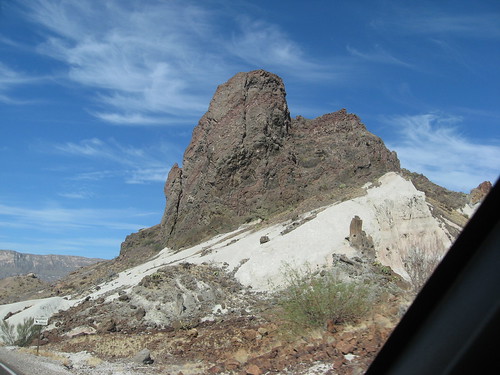
More "runny" volcanic rocks on top of an ash layer.
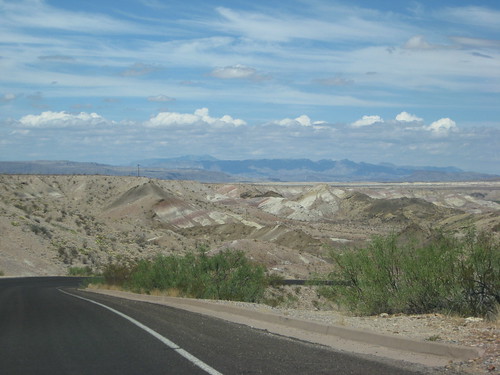
Cretaceous aged sedimentary rocks

Roadrunner
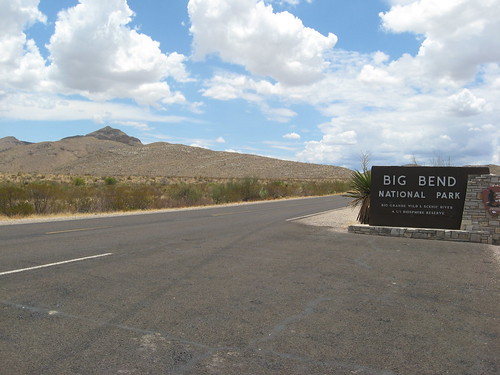
Welcome to Big Bend National Park
Further Reading:
The NPS pages on the Geology of Big Bend and the Fossils of Big Bend, as well as all the links included in the fossil page.
Long and very technical USGS Circular 1327: Geological, Geochemical, and Geophysical Studies by the U.S. Geological Survey in Big Bend National Park, Texas from 2008, from that link you can download the whole thing.
See many of the papers by Dr. Tom Lehman at Texas Tech University, and if you walk through the second floor of the building near his office you will see other posters and papers of his and his students research.
National Park Service Series homepage

No comments:
Post a Comment